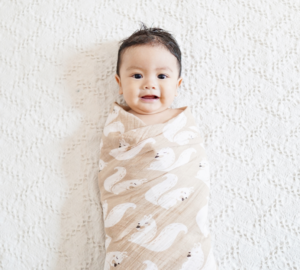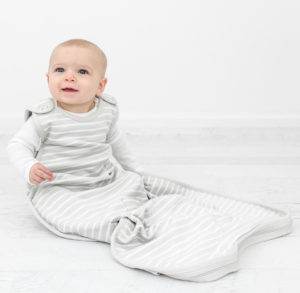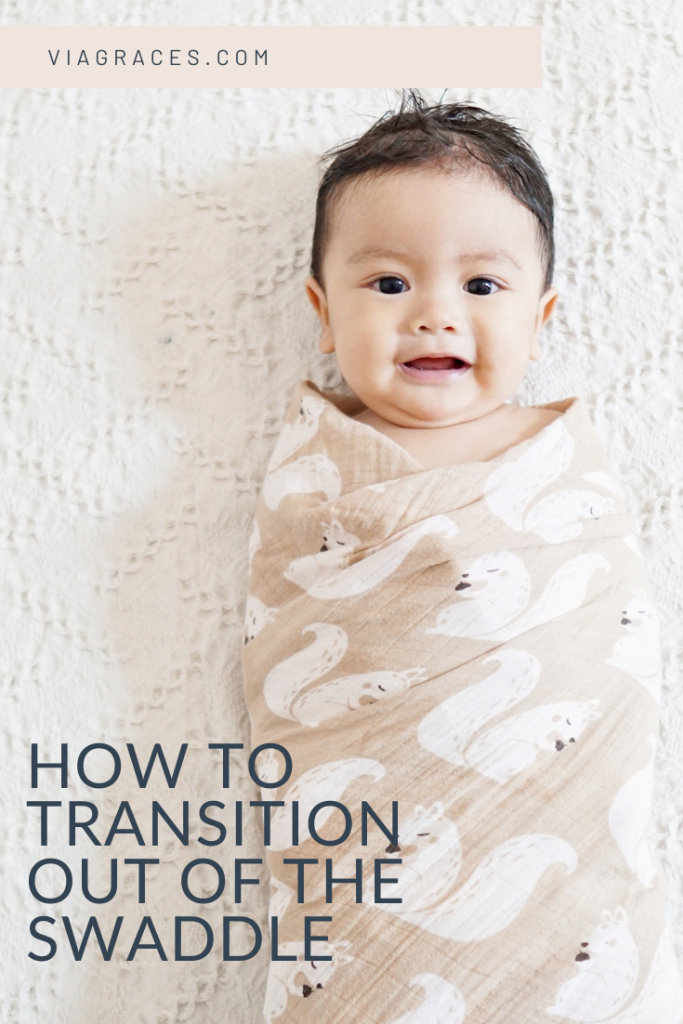One of my favorite aspects of newborn life is that sweet little baby burrito I get to snuggle. Swaddled babies are so cute! And swaddling is such an important piece of newborn sleep, but it’s also something that gets misused!
With my first, we swaddled her for naps and nighttime for four+ months. I actually remember attempting to transition her after Christmas two years ago, but she just wasn’t sleeping well.
So instead of transitioning her out of the swaddle, we just bought the largest size we could find!
Looking back, I think I blamed some of her poor sleep on the swaddle transition rather than her lack of independent skills. (Really, I blamed anything I could think of for her poor sleep because I didn’t want to admit that I didn’t know how to fix it!)
I knew she needed to be arms free by the time she rolled over, but I didn’t know much else. And thankfully for us, she didn’t roll over until closer to 6 months, so we were still “safe.” What I didn’t realize was that by keeping her swaddled, we were actually limiting her ability to self-soothe and actually making it take longer for that startle reflex to integrate!.

So in this post I’m going to walk you through what I wish I would have known the first time around, including:
- When you should stop swaddling your baby
- Two ways you can transition your baby out of the swaddle
- How your baby’s sleep might change when you stop swaddling
- What sleep sacks to use once you transition out of the swaddle
When to Transition Your Baby Out of the Swaddle
It is very important for our babies’ safety that they are no longer swaddled by the time they start attempting to roll over. Rather than basing the swaddle transition on a physical skill, however, I actually suggest basing the transition on age.
It is ideal to make the transition around 10 weeks; 8 weeks at the earliest, and 12 weeks at the latest. [Note: use your baby’s adjusted age when determining the best time to transition!]
It’s around that 10 week mark or so that babies are starting to discover they have these things called hands attached to their body. They don’t really know how to move them intentionally, but they’re slowly figuring it out. This is when a lot of babies start to suck on their fist or attempt to suck on their fingers.
Although that newborn startle reflex might not be totally gone yet at 10 weeks, part of that reflex fully integrating is having lots of time to practice using their bodies. And although it might sound scary, yes, sleeping without a swaddle at night is lots of great practice! And like I mentioned before, keeping a baby swaddled for much longer can actually make it take longer for that reflex to integrate – and no one wants that!
Also, having their hands and arms free is such a big part of babies learning to self-soothe – we want to let them decide if they want their hands up, or down, or by their face, or fist in the mouth. But to do this, we have to make sure we’re giving them that opportunity!
Finally, around four months there’s an actual physical change in babies’ sleep as they transition from two sleep cycles to four sleep cycles (ever heard of the four-month regression??). This adjustment in sleep cycles pairs well with gaining more control over their body, which is one of the big reasons we can officially start sleep training at four months!
I remember when we transitioned our third daughter out of the swaddle she started doing 360s in her sleep, so she was clearly trying to figure out how to use that little body and get comfortable!
Now that we know when it’s time to transition your baby out of the swaddle, let’s talk about how to transition them out of the swaddle.
How to Go About the Swaddle Transition
Method 1: Swaddle with one arm in, one arm out
This is what we have done with all four of our kiddos, and it’s my go-to if babies are young enough and have not yet attempted to roll over.
With this strategy, I always suggest starting at bedtime, as melatonin is on your baby’s side to help them with a big change.
Start by swaddling one arm in and keeping the other arm out of the swaddle. Then for the first night waking, switch arms. Then the next waking, switch again! For the first nap of the day, switch, and continue taking turns with which arm is swaddled in and which is out for each sleep, for three to four days.
Then leave both arms out, and you’re officially done swaddling your baby!
If you have something like the Ollie swaddle, you can transition with it by simply swaddling one arm in and leaving the other arm out.
Or you can use something like the HALO Sleepsack. I love that it allows you to easily swaddle one arm in and one arm out. I also love that once you’re done swaddling and have finished the transition, you can still velcro around your baby’s body to give them that secure feeling that the swaddle used to bring.

Now, If the one-arm-in-one-arm-out method seems too complicated and you’re just ready to be done swaddling, you can simply stop cold turkey!
Method 2: Stop Swaddling Cold turkey
Again, I suggest starting at bedtime, as daytime sleep is just harder in general. Then simply walk through your typical bedtime routine, but skip the swaddle, and then support your baby to sleep.
And remember, if your baby has started rolling, there’s not time for one arm in, one arm out – it’s time to cut that swaddle cold turkey!
What to Expect When Transitioning Out of the Swaddle
While transitioning out of the swaddle, you may notice it takes longer for your baby to fall asleep; they may need more help getting to sleep than usual, they may have more partial arousals than normal, and they may even have some short naps as a result.
And that’s understandable – this is their first little hands-free party! And like I already mentioned, that startle reflex might not actually be gone yet.
That will likely take some time. But transitioning out of the swaddle now will help your baby learn more control over their arms and don’t worry, the reflex will go away.
So once you decide it’s time to stop swaddling, make the transition and stick with it! Every baby is different but it might be 5-7 days before you feel like they’re finally adjusting – so hang in there.
What to Use When You Stop Swaddling
Whichever method you use to stop swaddling, I am a huge fan of moving into a normal, arms-free sleep sack from here, as it’s not safe to use blankets until your baby is at least 12 months old.

Putting them in a sleep sack gives me the confidence that my babies are warm, plus putting on a sleep sack is a great physical reminder that sleep is coming.
Read about my favorite sleep sacks here!
Do I have to transition from a swaddle to a sleep sack?
No! Your baby can absolutely be a great sleeper and not have them wear a sleep sack at all. I always strongly encourage newborn parents swaddle their babies, but after that sleep sacks are much more “optional.”
If you do not use a sleep sack for naps or bedtime, however, try to make sure your baby’s room is around 68-72 degrees Fahrenheit, so they’re not too hot or cold. And if you find your baby is too hot or cold, adjust accordingly!
Some parents put their babies in fleece pajamas in the winter and/or use fleece sheets in the winter. Similarly, some parents put their kids in lighter pajamas, or even short sleeve pajamas, in the summer months to help their child stay cool.
You can also add a fan to your baby’s room if they’re getting too warm at night!
Should I Use the Baby Merlin Magic Sleepsuit to Help the Transition?
When I talk about the swaddle transition as well as sleep sacks, I can’t not talk about the Merlin Sleep Suit. A lot of families use the Merlin as a transitional sleep sack, because babies are safe to wear it once they can roll, but it still prevents the startle reflex! So it feels less scary for parents.
But I’m really not a fan.
One, it’s really pricey for a very temporary sleep sack. And two, I don’t love that it prevents that startle reflex!
Remember how I said that the more practice babies have arms-free, the quicker that reflex integrates? The Merlin is just going to slow that down. And I want my babies to not only integrate that reflex, but I also want them to learn how to get cozy and decide what position they want to sleep in! And they simply can’t do that in the Merlin.
So whenever I’m working with families through the swaddle transition, we say no to the Merlin. And if I’m working with a family currently in the Merlin and they’re ready to sleep train? We stop using it cold turkey!
Conclusion
One of my favorite parts of newborn life is seeing those cute little baby burritos – and watching the big stretch that happens when we take the swaddle off.
But there comes a time when it is best for our little ones’ sleep and development to transition out of the swaddle, and while that can be a scary transition, it is good!
I certainly move around in my sleep and would not want to be restrained from doing so – when we stop swaddling our babies we’re giving them more freedom to learn in what positions they most prefer to sleep!
When approaching any transition with your child, specifically when it comes to sleep, I want families to feel confident navigating their little one’s sleep; I want you to have a plan.
So take what you’ve learned in this blog post today, make a plan for when you’ll start the transition and how you’ll do it, and stick with it! I promise you’ll get out on the other side.
It’s certainly a change for babies but it’s a necessary step on their journey toward good sleep (and yours!).
Also remember that you may have some tougher nights or tougher days throughout the swaddle transition. Remember that’s normal and to hang in there! And maybe make a plan with your spouse to share night waking duties, or ask Grandma to come over during the day to help with the other kiddos since the short naps are making you crazy.
And finally, if you’re nervous about this whole transition, know that that’s what we’re here to help with! If your little one is still a newborn, under 16 weeks old, that’s what Newborn Sleep from A to Z is all about. In that online sleep class, I chat about all things newborn sleep and talk through practical steps to help establish a solid sleep foundation, whether that’s before or after the swaddle transition.
Or if your baby is older than 16 weeks and maybe the swaddle transition just made sleep really hard, or their currently in the Merlin and you’re terrified of transitioning out? We’d love to help you make a plan and stick to it, so after two weeks your baby can not only sleep without the Merlin, but fall asleep on their own within a few minutes of being put down. Learn more about how we can support you here.
With Grace,
Lauren
Note that this blog contains an affiliate link, but the review is from my personal use.
